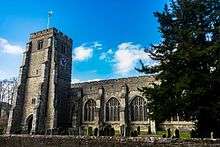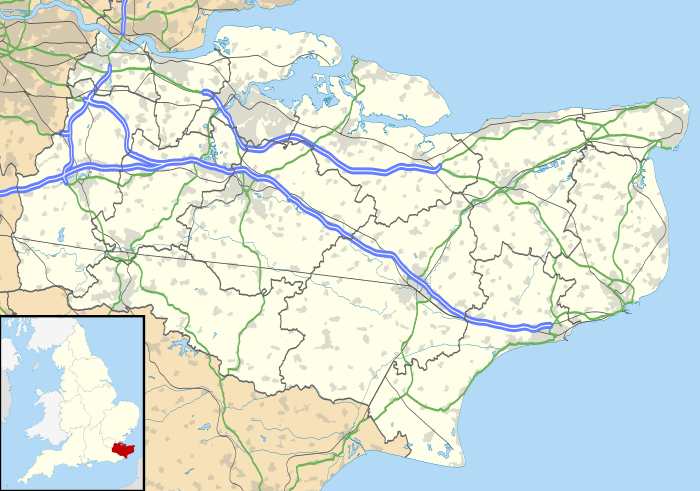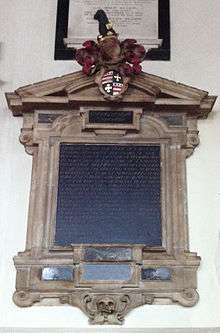All Saints Church, Maidstone
All Saints is a parish church in Maidstone, Kent. It is a Grade I listed building, and has been described as the grandest Perpendicular style church in Kent.[1]
| All Saints Church | |
|---|---|
 South side of the church | |
 Location within Kent | |
| Location | Maidstone, Kent |
| Country | England |
| Denomination | Anglican |
| Website | http://www.maidstoneallsaints.co.uk/ |
| History | |
| Status | Parish church |
| Founded | 1395 |
| Founder(s) | Archbishop William Courtenay |
| Architecture | |
| Functional status | Active |
| Heritage designation | Grade I |
| Designated | 30 July 1951 |
| Style | Perpendicular |
| Completed | 1396–1398 |
| Specifications | |
| Materials | Rag-stone |
| Bells | 10 (full circle) |
| Tenor bell weight | 32 long cwt 0 qr 20 lb (3,604 lb or 1,635 kg) |
| Administration | |
| Parish | Maidstone, All Saints with St Philip and St Stephen, Tovil |
| Deanery | Maidstone |
| Archdeaconry | Maidstone |
| Diocese | Canterbury |
| Province | Canterbury |
Establishment and dissolution
Founded by Archbishop of Canterbury William Courtenay in 1395 as part of a new College of All Saints, the church replaced an earlier one on the site dedicated to St Mary.[2] Courtenay died in 1396 and the church and college were completed by his successor, Thomas Arundel, between 1396 and 1398.[1] Richard II endowed the college with land and income from the Hospital of St Peter and St Paul in Maidstone and from the parishes of Linton, Farleigh, Sutton and Crundale. The college was also granted the advowsons for the parishes.[3] To cover the cost of building the college, Courtenay obtained a bull to levy a charge of fourpence in the pound on all ecclesiastical revenue raised in his archbishopric.[2][note 1]
When the college was closed in 1546 following the passing of the Chantries Act, its annual income was valued at £208 6s 2d (equivalent to £125,000 in 2019).[3][4] The church and the college were separated. The church became the parish church for the whole of Maidstone and the college's estate was granted to George Brooke, Baron Cobham but was forfeited to the crown in 1603 when his grandson, Henry Brooke, the 11th Baron Cobham, was charged with high treason for his part in the Main Plot against James I.[2] In the reign of Charles I the college became the property of Sir Edward Henden and later passed into the family of the Earls of Romney.[2]
The building
The church sits in a small churchyard with the River Medway to the west, the remnants of the college, including its gateway, to the south, the Archbishop's Palace to the north-west and the palace's tithe barn to the north-east.[note 2] The medieval wall on the north and west sides of the churchyard and the Monckton War Memorial in the churchyard are both separately listed as Grade II structures.[6][7]
The church is built of rag-stone in the Perpendicular style with buttressed walls and a crenellated parapet. The tower is on the south-west corner and is 78 feet (24 m) tall.[1][8] It formerly had a spire, which was destroyed by a lightning strike in 1730.[1] It has a nave six bays long with aisles on the north and south sides with a clerestory running the length of the church. On the south side is a chapel originally for the use of the Fraternity of Corpus Christi, a local lay community.[1][2] The Credence and four-seated Sedilla incorporate a monument to the first master of the college, John Wotton (died 1417).[1][3] Further monuments exist to Archbishop Courtenay, Lawrence Washington (died 1619),[note 3] John Davy (died 1631) and a combined memorial to John Astley (died c. 1595), his son Sir John Astley (died 1639) and their wives.[1][10] Burials in the church include the Astleys, Washington and the three Barons Astley of Reading.[11] In the churchyard is the tomb of William Shipley, founder of the Royal Society of Arts.[12]
The font is early 17th century and the choir stalls feature medieval misericords.[1] The timber roof was replaced in 1886 to designs by John Loughborough Pearson.[1] Pearson also designed screens and the reredos.[10] The church tower has a ring of bells consisting of ten bells ranging from a treble of 5 long cwt 0 qr 26 lb (586 lb or 266 kg) to a tenor of 32 long cwt 0 qr 20 lb (3,604 lb or 1,635 kg). The bells are regularly rung by the church's bell ringing society.[8][13] The church clock was manufactured in 1899 by Gillett & Johnston and refurbished in 2007. It strikes the quarters and hours using Westminster chimes.[8][14]
The building is on the Historic England Heritage at Risk Register.[15]
Choirs

The church has male and female choir directed by the Director of Liturgical Music.[16]
See also
Notes and references
Notes
- In Courtenay's time there were 240 pence in the pound. The charge was therefore equal to 1.7% of income.
- The Archbishop's Palace, the Tithe Barn and the College Gateway are all Grade I listed buildings. The College and the Dungeons to the Palace are listed Grade II* and the gatehouse to the Palace and the walls around the Palace are listed Grade II.[5]
- Lawrence Washington was member of parliament for Maidstone from 1604 to 1611 and was the great-uncle of Lawrence Washington, great-great-grandfather of George Washington.[9] He was also the stepfather of Sir Samuel Argall, Governor of Virginia.
References
- Historic England. "Parish Church of All Saints (1225056)". National Heritage List for England. Retrieved 18 June 2011.
- Hasted, Edward (1798). "The town and parish of Maidstone: Churches, religious houses and charities". The History and Topographical Survey of the County of Kent. vol. 4. pp. 308–327. Retrieved 19 June 2011.
- Page, William, ed. (1926). "The College of Maidstone". A History of the County of Kent. vol. 2. pp. 232–33. Retrieved 19 June 2011.
- UK Retail Price Index inflation figures are based on data from Clark, Gregory (2017). "The Annual RPI and Average Earnings for Britain, 1209 to Present (New Series)". MeasuringWorth. Retrieved 2 February 2020.
- Historic England. "The Archbishop's Palace (1336232)". National Heritage List for England. Retrieved 26 June 2011.
Historic England. "Archbishop's Stables Carriage Museum The Tithe Barn (1336233)". National Heritage List for England. Retrieved 26 June 2011.
Historic England. "The College Gateway (All Saints Parish Room) The College Tower (1336234)". National Heritage List for England. Retrieved 26 June 2011.
Historic England. "The College (1225072)". National Heritage List for England. Retrieved 26 June 2011.
Historic England. "The Dungeons at the Archbishop's Palace (1086309)". National Heritage List for England. Retrieved 26 June 2011.
Historic England. "The Gate House at the Archbishop's Palace (1086310)". National Heritage List for England. Retrieved 26 June 2011.
Historic England. "Wall to North West of Archbishop's Palace (1086308)". National Heritage List for England. Retrieved 26 June 2011.
Historic England. "Wall to East of Archbishop's Palace (1224889)". National Heritage List for England. Retrieved 26 June 2011.
Historic England. "Gateway and Wall to Palace Gardens (1224844)". National Heritage List for England. Retrieved 26 June 2011. - Historic England. "Wall to North and West of All Saints Church (1086311)". National Heritage List for England. Retrieved 23 June 2011.
- Historic England. "Monckton War Memorial in All Saints Churchyard (1393766)". National Heritage List for England. Retrieved 23 June 2011.
- "The Bells in All Saints Church, Maidstone". Maidstone All Saints. Retrieved 20 June 2011.
- "The Washington Memorial". Maidstone All Saints. Retrieved 21 June 2011.
- "Our History and Heritage". Maidstone All Saints. Retrieved 20 June 2011.
- Hasted, Edward (1798). "The town and parish of Maidstone: Town and manors". The History and Topographical Survey of the County of Kent. vol. 4. pp. 260–307. Retrieved 26 June 2011.
- Allan, D. G. C. (October 2006). "Shipley, William (bap. 1715 d. 1803), founder of the Society for the Encouragement of Arts, Manufactures, and Commerce". Oxford Dictionary of National Biography. Oxford University Press. doi:10.1093/ref:odnb/25412. Retrieved 29 June 2011.
- Love, Dickon, "Maidstone, All Saints", Love's Guide to the Church Bells of Kent, retrieved 12 October 2018
- "The Tower Clock". Maidstone All Saints. Retrieved 20 June 2011.
- "Heritage At Risk: South East Register 2017" (PDF). Historic England. 2017. Archived from the original (PDF) on 3 January 2018. Retrieved 2 January 2018.
- "The Choirs of All Saints' Maidstone". Maidstone All Saints. Archived from the original on 26 June 2016. Retrieved 2 June 2016.
External links
| Wikimedia Commons has media related to All Saints Church, Maidstone. |
- Corpus Vitrearum Medii Aevi, Maidstone: All Saints Image of the medieval stained-glass window in Vestry.